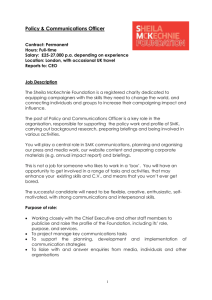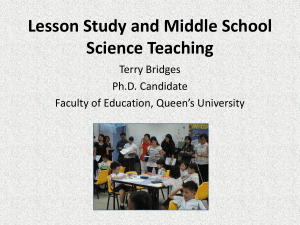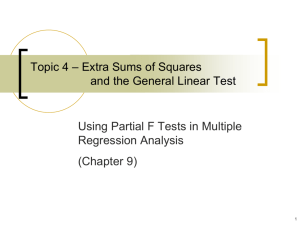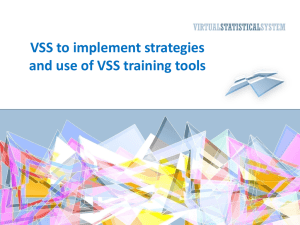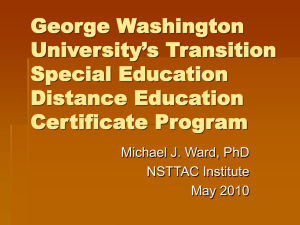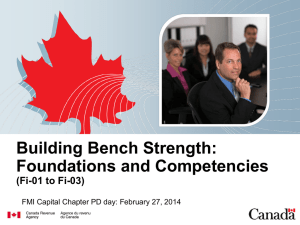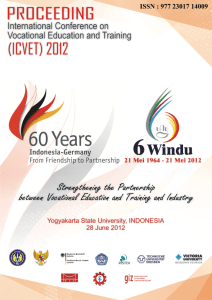Click to add title - OIC-VET
advertisement
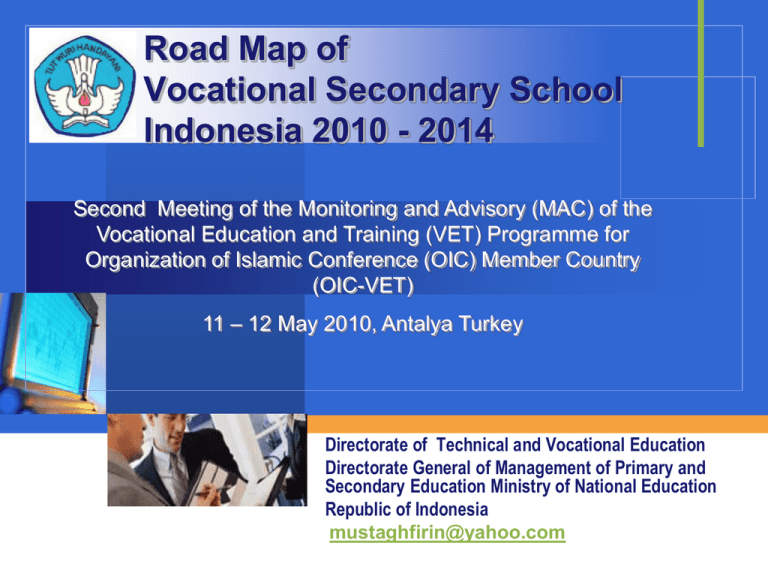
Road Map of Vocational Secondary School Indonesia 2010 - 2014 Second Meeting of the Monitoring and Advisory (MAC) of the Vocational Education and Training (VET) Programme for Organization of Islamic Conference (OIC) Member Country (OIC-VET) 11 – 12 May 2010, Antalya Turkey Directorate of Technical and Vocational Education Company Directorate General of Management of Primary and Secondary Education Ministry of National Education LOGO Republic of Indonesia mustaghfirin@yahoo.com CONTENTS 1. Introduction 2. Future challenges of SMK 3. Statitical data of Man Power 4. Students’ profile of SMK 5. Road Map of VSS 2010- 2014 6. VSS Education system in Indonesia 7. Revitalization VSS Competencies 2 More education with less independencies 3.28 HE 83.18 6.14 3.93 3.12 SS 15.13 0.35 60.87 7.5 11.69 2.55 JSC 18.8 2.26 39.2 10.3 6.23 23.44 2.03 Element Sch 19.71 28.59 13.52 26.53 9.87 1.78 < Elementary Sch 20.07 22.56 14.98 12.22 28.67 1.49 0% 20% Self Entrepreneur Entreprep+Permannt worker Feelance Source: BPS, Susenas 2003 40% 60% 80% 100% Entrepreneur + Non Permanent workers Worker Family worker 3 INDONESIAN MAN POWER STRUCTURE Expert Skill Workers Unskilled Workers Sources : BPS 2006 4 04,8 million 20,4 million 81,1 million Moving targets Future supply of upper-secondary graduates 14,000,000 12,000,000 10,000,000 8,000,000 2003 2010 6,000,000 2015 4,000,000 2,000,000 0 China EU India US Indonesia Education Level, work force, employee, and unemployment in 2006 Education Level Structure of Work Force Employees structure Million Million % % Unemployment structure Million % Elementary school or less 56.47 53.13 52.95 55.63 2.84 25.60 Junior HS 21.90 20.61 19.04 20.01 4.02 36.23 Senior Secondary 14.80 13.93 11.96 12.57 1.68 15.13 Vocational Sec. Sch 7.13 6.71 5.93 6.23 0.80 7.20 Associate (Polythecnics) 2.45 2.30 2.15 2.26 0.45 4.08 University 3.53 3.32 3.16 3.31 1.31 11.76 106.28 100 95.18 100 11.11 100 Amount Sources : BPS 2006 6 CONSIDERATIONS IN DEVELOPING TECHNICAL AND VOCATIONAL EDUCATION 7 THREE PILARS OF MINISTRY OF NATIONAL EDUCATION POLICIES MONE ACCESS ENLARGMENT IN EDUCATION 8 QUALITY IMPROVEMENT AND RELEVANCE ACCOUNTABILITY AND PUBLIC IMAGE INTRODUCTION 1. SMK is an integral part of economical sector that devoted to support national economic growth. It is therefore SMK systems needs to be improved both in quality and quantity; 2. SMK quality reflects the Indonesian manpower quality, that needs to be developed continuously to improve the competitiveness of the Indonesian human resources; 3. SMK plays an important role to reduce jobless index in the state-wide; 4. To be able to perform in the labour market SMK’s should work hand in hand with the industries partner and employers should have a significant role in enhancing technical and vocational education policies. 9 STUDENTS’ PROFILE Spiritually Intelligence Be able to actualize through hearth and mind for growing and strengthening faith, pious, and excellent characters, includes wise and excellent personality. • supreme Be able to self-actualize and sensitize for personality and improving sensitivity and appreciation respect in toward gentleness and beautiful in both art Excellency and cultural, and having competence to • high spirit express its. Emotional & • be autonomous Social Be able to actualize by means of social • never to give up interaction to: creating and fertilizing mutual Intelligence interaction; democratic, empathy and • networking sympathy, respect in human right, cheerful enhancer Competitive confidence, respect to diversity in unity to • ready for change society and state; having nation hemisphere • Innovative and to aware with right and duty as a citizens. agent of change Be able to actualize through thinking for • Productive having competency and autonomy in both • Quality awareness Intellectual science and technology; • Globally Intelligence Be able to actualize to be critical, creative, orientation and imaginative person; • Life long learning Be able to actualize through sport for creating health, fit, endure, efficient, Kinestical skillful, and quick moving; Intelligence Be able to actualize to be a fit person 10 POLICIES 1. 2. 3. 4. 5. 6. 11 Instilling entrepreneurship subject in any Technical and Vocational Training. The promotion of self-employment is regarded as a forward-looking concept which will help to ease the labor market situation Particular attention should be given to planning the development and expansion of vocational education by giving high priority in national development agendas, evaluating national needs, providing appropriate current and future allocation of financial resources Employer should have greater involvement in national technical education policy making and they should be consulted in the major technical education and training initiatives Strengthening Training in Mastery of Key Competencies (Basic Skill of Literacy, Math (numeric), Communication Skill - Problem Solving, Adaptation to New Technology (Digital Literacy), and Teamwork Providing Continuing Education and Training Developing competency standards and recognition and certification of Skill MILESTONE MoNE 2010 - 2014 1. 2. Participation rate for secondary education reaches 62.5% School grant for SS/SMK starts to be applied with regard to selective school 3. 75% school facilities meet the criteria of National Standard 4. Rebuilding SS/SMK 100% 5. At least 1 business unit comes with every SMK 6. 100% of SS/SMK has a library 7. Every district/town has at least 1 pioneering outstanding local-based SMK or international standardized SMK 8. 50% of SS/VSS having access to apply ICT based learning 9. 1 texts book/student for the subject to be rationally examined 10. Student Ratio of SS : SMK/VSS = 60 : 40 11. 100% SS/SMK implements school-based management well 12 Vocational Teachers S IDEAL EXISTING NEEDS Teachers Teachers 29,651 45,697 (16,046) - S Normative Teachers 59,302 53,322 5,980 - S Adaptive Teachers 88,953 70,788 18,165 - S Productive Teachers 177,906 169,807 TOTAL • Normative Teacher is teacher for Religion, sport, Indonesian Language subject matters. • Adaptive Teachers is teachers for science, Math, Chemistry, ICT and Biology. • Productive Teachers are teachers for occupational skill subject matters (automotive, cooking, etc) 13 CHALLENGE OF SMK /VSS Obsolescent of School Facilities Teachers Quality and Quantity Concept of Local Advantages Changing of Work Pattern SMK Population Growth Economic Globalization Changing of Economic Structure 14 Development of Technology ECONOMIC GROWTH Gross Domestic Products (GDP) based on Constant Price 2002 (Billion Rp) 700 Manufacturing Industry 600 Trade, Hotel & Restaurant Agriculture, Livestock, Forestry & Fishery 500 Mining & Quarrying 400 Services 300 Financial, Ownership & Business Services 200 Construction 100 Transport & Communication Electricity, Gas & Water Supply 0 2002 15 2003 2004 2005 2006 2007* 2008* Source : BPS 2006 & Depnakertrans 2006 ECONOMIC GROWTH Labour Development and its Distribution in Indonesia Based on Primary Work Fields (in thousand) 50,000 Agriculture, Livestock, Forestry & Fishery 45,000 40,000 Trade, Hotel & Restaurant 35,000 Manufacturing Industry Services 30,000 25,000 Transport & Communication 20,000 Construction 15,000 Financial, Ownership & Business Services 10,000 Mining & Quarrying 5,000 Electricity, Gas & Water Supply 0 16 Source : BPS 2006 & 2004 2005 2006 2007* 2008* Depnakertrans 2006 NUMBER OF STUDENTS BASED ON ECONOMIC SECTOR Number of Students Based On Economic Sector Number of Student (million)) Processing Industries 1.2 Trading, Hotel, and Restaurant Agricultural, Plantation, and Fishery Community 1 0.8 services & others 0.6 Mining & Excavated object Finance 0.4 0.2 Transportation and Communication Building 0 2006 2007 2008 Years 17 2009 Electricity, Gas and Drinking Water Multi Entri & Multi Exit system Legend : SS JSS 18 18 FLEXIBLE PATHWAYS To cope with continuous and radical change of technology and economic environment, SMK should provide training that are flexible, on demand, interactive, and applying multiple entry and exit in responding to these changes In vocational and technical education system as well as at the post school, it is necessary to provide flexibility so that people who make one choice are not subsequently locked out of access to other courses or education system. As identified that there are many potential SMK student or workers those are willing to study while they are working. This needs to be made possible through bridging courses so there is no need for people to start from the beginning when they want to extend their knowledge and skill. 19 PATHWAYS TO COMPETENCY CERTIFICATES STANDARDS based on INDUSTRY ENTERPRISE -PUBLIC INSTITUTION needs RPL Bridging program Formal Courses This figure shows the ways in which certify Cates of competency and formal academic qualifications can be achieved RPL RPL Bridging program Bridging program Non-formal Courses On the Job Training Certificate of Competency could be achieved through one or a mixture of each process STTB/Diploma could be achieved EXAMINATION ASSESSMENT either from formal or non-formal courses and On the Job Training through Recognition of Prior Learning (RPL) Transferability between pathways Skills Passport STTB / DIPLOMA 20 CERTIFICATE of COMPETENCY is done through RPL, bridging courses / training CERTIFICATION SYSTEM It is importance to open access for other training provider to a system of skills certificates so that the competencies learned by students/workers can be recognized, regardless time and venue constrains. It is also designed to give students a clear statement of their skills attainment which they can show to prospective employers by providing skills passport. 21 Revitalization of VSS’ Competencies 1. 2. 3. 4. 5. 6. 7. In 2010 Indonesia has 7800 VSS with 3.4 Million student. Total Teachers 2.783.321; Indonesia has 173 VSS programs; Every program has own standard competencies Every program has 2- 3 competencies; Every 4-5 years, representative person from industry doing review the programs; Every 5 years accreditation for every program in VSS by National Accreditation Committee; In every VSS has at least 1 Testing Center for 1 competencies. 22 “ Mechatronics “ is blended competencies from Mechanics, Electronics and ICT 23 “Restaurant Service” “ Cookery” 24 “ Ladies & Men’s Hairdressing “ 25 ”Cabinet Making” 26 “AUTOMOTIVE“and “ CAD” Machine 27 “ Ladies Dressmaking “ 28 multi intelligences develop the skills 29 Notebook assembly MULTIPURPOSE HAND TRACTOR 31 MULTIPURPOSE HAND TRACTOR 32 Assembly motor cycle to develop comprehensive skills 33 Assembly motor cycle to develop comprehensive skills 34 Production skills = Foundry Facilities, cooperation with SME 35 Camshaft Production 36 Machining Intake Manifold Casting Parts Facing & drilling on milling machine 37 Crank Shaft Casting Part 38 Machining Components Production 39 Engine Esemka 1.5i 40 THANK YOU 41
